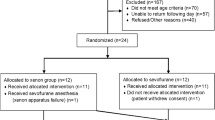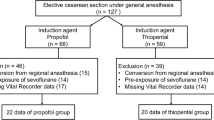Abstract
Objective
This study investigated the suitability of various electroencephalogram (EEG) parameters to describe anaesthetic drug effects in propofol-remifentanil anaesthesia. The investigated parameters were the Narcotrend® Index (NI), the Bispectral IndexTM (BISTM), and standard spectral and entropy parameters. Additionally, it was investigated whether the effect of a fixed dosage of propofol on the attained depth of hypnosis during induction of anaesthesia is different in male and female patients.
Methods
Standardized inductions of anaesthesia in 10 male and 10 female patients (ASA status I or II, 15–75 years) were analysed. All patients received 4 mg propofol/kg over 6 min followed by 4 mg/kg/h. For analgesia, patients received 0.3 µg/kg/min remifentanil starting 2 min before propofol application. For EEG monitoring, the Narcotrend and the Aspect A-2000 Bispectral Index monitor were used simultaneously. Data from start of propofol injection until 1 min after the end of the induction period (420 s) were used for statistical analysis. EEG parameters were evaluated every 10 s.
Results
The Narcotrend® Index and the Bispectral IndexTM had the highest mean correlations with the calculated propofol effect-site concentration and were able to distinguish stages from the awake state or the near awake state and stages of deep hypnosis. On the Narcotrend scale, more data points are available for levels of anaesthesia with relevance for maintenance of anaesthesia. The BIS values at the first occurrence of burst suppression were significantly higher than the corresponding NI values. During induction of anaesthesia, the same dosages of propofol (per kg body weight) given to men and women did not show different effects on the EEG.
Conclusions
NI and BIS are superior to␣spectral and entropy parameters in describing changes of propofol concentration during induction of propofol-remifentanil anaesthesia.
Similar content being viewed by others

References
Priestley M. Spectral analysis and time series, Academic press: London 1981.
Schwender D, Daunderer M, Mulzer S, Klasing S, Finsterer U, Peter K. Spectral edge frequency of the electroencephalogram to monitor depth of anaesthesia with isoflurane or propofol. Br J Anaesth 1996;77:179–184.
Sigl J, Chamoun N. An introduction to bispectral analysis for the electroencephalogram. J Clin Monit 1994;10:392–404.
Shannon CE. A mathematical theory of communication. Bell Syst Tech J 1948; 27: 379–423, 623–656.
Inouye T, Shinosaki K, Sakamoto H, et al. Quantification of EEG irregularity by use of the entropy of the power spectrum. Electroencephalogr Clin Neurophysiol 1991;79:204–210.
Bruhn J, Lehmann LE, Röpcke H, Bouillon TW, Hoeft A. Shannon entropy applied to the measurement of electroencephalographic effects of desflurane. Anesthesiology 2001;95:30–35.
Grassberger P, Procaccia I. Estimation of the Kolmogorov entropy from a chaotic signal. Phys Rev 1983;A28:2591–2593.
Grouven U, Beger FA, Schultz B, Schultz A. Correlation of Narcotrend Index, entropy measures, and spectral parameters with calculated propofol effect-site concentrations during induction of propofol-remifentanil anaesthesia. J Clin Monit 2004;18:231–240.
Marsh B, White M, Morton N, Kenny GNC. Pharmacokinetic model driven infusion of propofol in children. Br J Anaesth 1991;67:41–48.
Kreuer S, Molter G, Biedler A, Larsen R, Schoth S, Wilhelm W. Narcotrend stages and end-tidal desflurane concentrations. An investigation during recovery from desflurane/remifentanil anaesthesia (in German). Anaesthesist 2002;51:800–804.
Kreuer S, Biedler A, Larsen R, Altmann S, Wilhelm W. NarcotrendTM monitoring allows faster emergence and a reduction of drug consumption in propofol-remifentanil anesthesia. Anesthesiology 2003;99:34–41.
Münte S, Münte TF, Grotkamp J, et al. Implicit memory varies as a function of hypnotic electroencephalogram stage in surgical patients. Anesth Analg 2003;97:132–138.
Schultz B, Grouven U, Schultz A. Automatic classification algorithms of the EEG monitor Narcotrend for routinely recorded EEG data from general anaesthesia: a validation study. Biomed Tech 2002;47:9–13.
Wilhelm W, Kreuer S, Larsen R. Narcotrend-Studiengruppe. Narcotrend EEG monitoring during total intravenous anaesthesia in 4.630 patients (in German). Anaesthesist 2002;51:980–988.
Schultz A, Grouven U, Beger FA, Schultz B. The Narcotrend Index: classification algorithm, correlation with propofol effect-site concentrations, and comparison with spectral parameters. Biomed Tech 2004;49:38–42.
Johansen JW. Update on Bispectral Index monitoring. Best Pract Res Clin Anaesthesiol 2006;20:81–99.
Rampil IJ, Lockhart SH, Eger EI, Yasuda N, Weiskopf RB, Calahan MK. The electroencephalographic effects on desflurane in humans. Anesthesiology 1991;74:434–439.
Pincus SM, Gladstone IM, Ehrenkranz RA. A regularity statistic for medical data analysis. J Clin Monit 1991;7:335–345.
Smith WD, Dutton RC, Smith NT. Measuring the performance of anesthetic depth indicators. Anesthesiology 1996;84:38–51.
Kreuer S, Wilhelm W, Grundmann U, Larsen R, Bruhn J. Narcotrend index versus bispectral index as electroencephalogram measures of anesthetic drug effect during propofol anesthesia. Anesth Analg 2004;98:692–697.
Kreuer S, Bruhn J, Larsen R, Grundmann U, Shafer SL, Wilhelm W. Application of Bispectral Index and Narcotrend Index to the measurement of the electroencephalographic effects of isoflurane with and without burst suppression. Anesthesiology 2004;101:847–854.
Weber F, Gruber M, Taeger K. The correlation of the Narcotrend Index and classical electroencephalographic parameters with endtidal desflurane concentrations and hemodynamic parameters in different age groups. Paediatr Anaesth 2005;15:378–384.
Weber F, Hollnberger H, Gruber M, Frank B, Taeger K. The correlation of the Narcotrend Index with endtidal sevoflurane concentrations and hemodynamic parameters in children. Paediatr Anaesth 2005;15:727–732.
Bruhn J, Röpcke H, Rehberg B, Bouillon T, Hoeft A. Electroencephalogram approximate entropy classifies the occurrence of burst suppression pattern as increasing anesthetic drug effect. Anesthesiology 2000;93:981–985.
Schultz A, Grouven U, Schultz B. SEF90, SEF95 and the median do not discriminate deep EEG stages during propofol/remifentanil anaesthesia. Eur J Anaesthesiol 2000;17(Suppl 19):22.
Struys MM, Coppens MJ, De Neve N, Mortier EP, Doufas AG, Van Bocxlaer J, Shafer SL. Influence of administration rate on propofol plasma-effect site equilibration. Anesthesiology 2007;107(3):386–396.
Koitabashi T, Johansen JW, Sebel PS. Remifentanil dose/electroencephalogram bispectral response during combined propofol/regional anesthesia. Anesth Analg. 2002;94(6):1530–1533.
Kreuer S, Bruhn J, Larsen R, Bialas P, Wilhelm W. Comparability of NarcotrendTM index and bispectral index during propofol anaesthesia. Br J Anaesth 2004;93:235–240.
Johansen JW, Sebel PS. Development and clinical application of electroencephalographic bispectrum monitoring. Anesthesiology 2000;93:1336–1344.
Schultz A, Kneif T, Grouven U, Schultz B. EEG monitoring for control of sedation: shortening of treatment in the ICU (in German). Klin Neurophysiol 2007;38:198–202.
Author information
Authors and Affiliations
Corresponding author
Additional information
Drs. U. Grouven, A. Schultz and B. Schultz are members of the research group that developed the classification algorithms implemented in the EEG monitor Narcotrend.
Schultz A, Siedenberg M, Grouven U, Kneif T, Schultz B. Comparison of Narcotrend Index, Bispectral Index, spectral and entropy parameters during induction of propofol-remifentanil anaesthesia.
Rights and permissions
About this article
Cite this article
Schultz, A., Siedenberg, M., Grouven, U. et al. Comparison of Narcotrend Index, Bispectral Index, spectral and entropy parameters during induction of propofol-remifentanil anaesthesia. J Clin Monit Comput 22, 103–111 (2008). https://doi.org/10.1007/s10877-008-9111-6
Received:
Accepted:
Published:
Issue Date:
DOI: https://doi.org/10.1007/s10877-008-9111-6



